South Texas | |
|---|---|
 San Antonio skyline | |
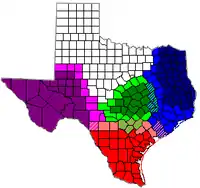 South Texas counties in red | |
| Country | |
| State | |
| Largest city | San Antonio |
| Population | |
| • Total | 4,992,597 |
South Texas is a region of the U.S. state of Texas that lies roughly south of—and includes—San Antonio. The southern and western boundary is the Rio Grande, and to the east it is the Gulf of Mexico. The population of this region is about 4.96 million according to the 2017 census estimates.[1] The southern portion of this region is often referred to as the Rio Grande Valley. The eastern portion along the Gulf of Mexico is also referred to as the Coastal Bend.
Greater Houston and Beaumont–Port Arthur are occasionally tied to the region, both for physically being on the southern end of the state and for businesses that use "South Texas" in its name. (i.e. South Texas School of Law, South Texas State Fair, etc). However, the two are more commonly associated with East Texas or Southeast Texas.
Geography

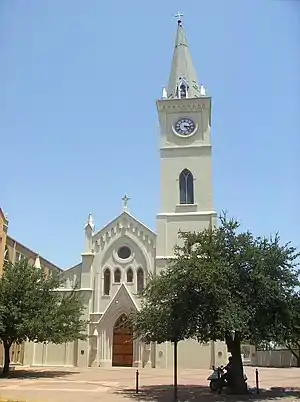
There is no defined northern boundary, although it is believed to be at the city of San Antonio and from an east to west line extending from the Rio Grande near Maverick County to the Gulf of Mexico, but turning southeast at or near Lavaca County, and continuing towards the Gulf of Mexico to separate it from East Texas and Southeast Texas. The Rio Grande serves as the western and southern boundaries and separates Texas from Mexico. The eastern portion of South Texas is bordered by the Gulf of Mexico. South Texas consists of 41 counties. Its terrain is flat, lying on the coastal plain. South Texas is so vast, that there are even subregions. The very southern tip of South Texas, called the Rio Grande Valley, has fertile soils and is known for its citrus production. The eastern portion of South Texas is often referred to as the Coastal Bend; here, coastal salt marshes, estuaries, and wetlands are scattered all around. The western and central parts are known as the South Texas Plains or the Brush Country. Mesquite trees and crop fields dominate the Brush Country.
Counties

Cities
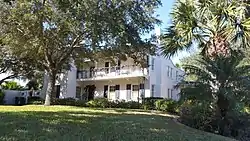
| Region Rank | City | 2020 Census | 2010 Census | % change | County |
|---|---|---|---|---|---|
| 1 | San Antonio | 1,434,625 | 1,327,407 | +8.08% | Bexar County |
| 2 | Corpus Christi | 317,863 | 305,215 | +4.14% | Nueces County |
| 3 | Laredo | 263,640 | 236,091 | +11.67% | Webb County |
| 4 | Brownsville | 186,738 | 175,023 | +6.69% | Cameron County |
| 5 | McAllen | 142,210 | 129,877 | +9.50% | Hidalgo County |
| 6 | Edinburg | 100,243 | 77,100 | +30.02% | Hidalgo County |
| 7 | Mission | 85,778 | 77,058 | +11.32% | Hidalgo County |
| 8 | Pharr | 79,715 | 70,400 | +13.23% | Hidalgo County |
| 9 | Harlingen | 71,829 | 64,849 | +0.95% | Cameron County |
| 10 | Victoria | 65,534 | 62,592 | +4.70% | Victoria County |
| 11 | Schertz | 42,002 | 31,465 | +33.49% | Guadalupe County |
| 12 | Weslaco | 40,160 | 35,670 | +12.59% | Hidalgo County |
| 13 | San Juan | 35,294 | 33,856 | +4.25% | Hidalgo County |
| 14 | Seguin | 29,433 | 25,175 | +16.91% | Guadalupe County |
| 15 | Eagle Pass | 28,130 | 26,248 | +7.17% | Maverick County |
| 16 | Converse | 27,466 | 18,198 | +50.93% | Bexar County |
| 17 | Kingsville | 25,402 | 26,213 | -3.09% | Kleberg County |
| 18 | San Benito | 24,861 | 24,250 | +2.52% | Cameron County |
| 19 | Universal City | 19,720 | 18,530 | +6.42% | Bexar County |
| 20 | Alamo | 19,493 | 18,353 | +6.21% | Hidalgo County |

Some people consider Houston to be in South Texas for several reasons: numerous businesses in the Houston region contain 'South Texas' in their titles.[2] The United States District Court for the Southern District of Texas includes the Houston division. However, Houston is most accurately classified as being within Southeast Texas, a subregion of East Texas.
Rivers
| Name | Note |
| Rio Grande | The border between Texas and Mexico |
| Nueces River | At one time considered by Mexico as the border between Texas and Mexico |
| San Antonio River | Part of the river is the location of San Antonio's Famous River Walk. |
| Aransas River | A short river that drains in Copano Bay. |
| Frio River | A fairly cold river, hence the name Frio, which means "cold" in Spanish. |
| Atascosa River | A short river that empties into the Frio River |
| Mission River | Flows into Mission Bay |
| Leona River | A tributary of the Frio River, within the Nueces River Basin |
| Guadalupe River | Flows into the San Antonio Bay estuary at Guadalupe Bay |
Lakes and reservoirs
Bays

- Corpus Christi Bay
- San Antonio Bay
- Baffin Bay
- Nueces Bay
- Oso Bay
- Copano Bay
- Aransas Bay
- Matagorda Bay
- Lavaca Bay
- Redfish Bay
- Mission Bay
Estuaries and waterways
- Rincon Bayou - a bayou in the Nueces River Delta, just north of the mouth of the Nueces River, for Location, see Nueces Bay
- Elm Bayou - a bayou on the Victoria-Refugio County line
- Gulf Intracoastal Waterway - a navigable route along the Gulf of Mexico without many of the hazards of travel on the open sea
- Resacas of the Rio Grande Valley - many oxbow lakes found scattered throughout the lower Rio Grande Valley
- Laguna Madre - a long, hypersaline bay that creates a barrier between Padre Island and mainland Texas
Islands
Climate
The climate of South Texas is varied. The area along the Mexican border is generally semi-arid (Köppen climate classification BSh), while the area from the coast inland to just west of San Antonio has a humid subtropical climate (Köppen Cfa). South Texas weather is affected by the Sierra Madre Oriental mountains to the west, the Gulf of Mexico to the east, and the Chihuahuan Desert to the west/northwest. Moisture from the Pacific is cut off by the Mexican Sierra Madre Occidental and Oriental mountain ranges. Along the coast the climate is best exemplified in the summers when humidity is extremely high though at times arid, depending upon whether tropical moisture from the Gulf and sometimes from the Pacific is flowing in or if the region is cut off from any moisture by high pressure systems, causing long droughts, which occur every few years. Temperatures reach freezing only a few times in the winter and snowfall is rare, usually three inches or less. Summers in this zone are hot and humid, with daily averages above 90 °F or 32.2 °C. In addition, areas in Texas that are slightly inland from the Gulf of Mexico, such as San Antonio that border the semi-arid climate zone, generally see a peak of precipitation in the spring, and a deep, drought-like nadir in midsummer. The region itself sees a short wet season from March to May and another one from late August to October, and a dry season elsewhere in the year. Night-time temperatures are around 85 °F or 29.4 °C in summer. The region of South Texas includes the semi-arid ranch country and the wetter Rio Grande Valley. Considered to be the southernmost tip of the American Great Plains region, the inland region has rainfall similar to that of the Northern Plains. The coastal areas are warm most of the year due to currents of the Gulf of Mexico, but can get cold in winter if a strong front comes in, occasionally causing snow at sea level. Rain in the coastal region is more abundant than in the inland region, and subtropical forests line the Rio Grande. Inland, where it is drier, ranches dominate the landscape, characterized by thick, spiny brush and grasslands. The winters in the inland region are cooler and drier, as Arctic air can make it into the region, but snow is rare due to the lack of humidity. Summers are for the most part hot and dry, but at times can be humid if winds come off the warmer Gulf of Mexico. Tornadoes can occur in this region, but less frequently than in other parts of the state.
| Climate data for San Antonio (San Antonio Int'l), 1991–2020 normals,[lower-alpha 1] extremes 1885–present[lower-alpha 2] | |||||||||||||
|---|---|---|---|---|---|---|---|---|---|---|---|---|---|
| Month | Jan | Feb | Mar | Apr | May | Jun | Jul | Aug | Sep | Oct | Nov | Dec | Year |
| Record high °F (°C) | 89 (32) |
100 (38) |
100 (38) |
101 (38) |
104 (40) |
108 (42) |
107 (42) |
110 (43) |
111 (44) |
99 (37) |
94 (34) |
90 (32) |
111 (44) |
| Mean maximum °F (°C) | 80.3 (26.8) |
84.9 (29.4) |
88.9 (31.6) |
92.2 (33.4) |
96.0 (35.6) |
98.9 (37.2) |
100.5 (38.1) |
102.1 (38.9) |
98.7 (37.1) |
93.1 (33.9) |
85.1 (29.5) |
80.6 (27.0) |
103.8 (39.9) |
| Mean daily maximum °F (°C) | 63.3 (17.4) |
67.5 (19.7) |
73.8 (23.2) |
80.3 (26.8) |
86.6 (30.3) |
92.4 (33.6) |
94.9 (34.9) |
96.0 (35.6) |
90.1 (32.3) |
82.2 (27.9) |
71.7 (22.1) |
64.7 (18.2) |
80.3 (26.8) |
| Daily mean °F (°C) | 52.2 (11.2) |
56.3 (13.5) |
62.8 (17.1) |
69.4 (20.8) |
76.5 (24.7) |
82.6 (28.1) |
84.8 (29.3) |
85.5 (29.7) |
79.9 (26.6) |
71.3 (21.8) |
60.7 (15.9) |
53.5 (11.9) |
69.6 (20.9) |
| Mean daily minimum °F (°C) | 41.0 (5.0) |
45.1 (7.3) |
51.8 (11.0) |
58.4 (14.7) |
66.4 (19.1) |
72.7 (22.6) |
74.7 (23.7) |
74.9 (23.8) |
69.6 (20.9) |
60.4 (15.8) |
49.8 (9.9) |
42.4 (5.8) |
58.9 (14.9) |
| Mean minimum °F (°C) | 26.2 (−3.2) |
29.0 (−1.7) |
33.7 (0.9) |
41.6 (5.3) |
53.1 (11.7) |
65.3 (18.5) |
70.2 (21.2) |
69.4 (20.8) |
57.4 (14.1) |
41.8 (5.4) |
32.2 (0.1) |
27.4 (−2.6) |
23.5 (−4.7) |
| Record low °F (°C) | 0 (−18) |
4 (−16) |
19 (−7) |
31 (−1) |
42 (6) |
48 (9) |
60 (16) |
57 (14) |
41 (5) |
27 (−3) |
21 (−6) |
6 (−14) |
0 (−18) |
| Average precipitation inches (mm) | 1.96 (50) |
1.74 (44) |
2.31 (59) |
2.42 (61) |
4.40 (112) |
3.28 (83) |
2.41 (61) |
2.15 (55) |
3.88 (99) |
3.75 (95) |
2.08 (53) |
2.00 (51) |
32.38 (822) |
| Average snowfall inches (cm) | 0.0 (0.0) |
0.1 (0.25) |
0.0 (0.0) |
0.0 (0.0) |
0.0 (0.0) |
0.0 (0.0) |
0.0 (0.0) |
0.0 (0.0) |
0.0 (0.0) |
0.0 (0.0) |
0.0 (0.0) |
0.1 (0.25) |
0.2 (0.51) |
| Average precipitation days (≥ 0.01 in) | 6.9 | 7.4 | 8.5 | 6.4 | 8.3 | 7.0 | 5.0 | 4.7 | 6.9 | 6.4 | 6.4 | 7.4 | 81.3 |
| Average snowy days (≥ 0.1 in) | 0.0 | 0.3 | 0.0 | 0.0 | 0.0 | 0.0 | 0.0 | 0.0 | 0.0 | 0.0 | 0.0 | 0.0 | 0.3 |
| Average relative humidity (%) | 67.1 | 65.2 | 63.2 | 66.3 | 70.5 | 68.8 | 65.0 | 64.7 | 68.0 | 67.2 | 68.3 | 68.0 | 66.9 |
| Average dew point °F (°C) | 37.0 (2.8) |
39.9 (4.4) |
46.8 (8.2) |
55.6 (13.1) |
63.7 (17.6) |
68.4 (20.2) |
68.9 (20.5) |
68.5 (20.3) |
65.7 (18.7) |
57.0 (13.9) |
48.0 (8.9) |
40.1 (4.5) |
55.0 (12.8) |
| Mean monthly sunshine hours | 159.4 | 169.7 | 215.5 | 209.7 | 221.8 | 275.9 | 308.8 | 293.9 | 234.9 | 218.0 | 171.9 | 149.7 | 2,629.2 |
| Percent possible sunshine | 49 | 54 | 58 | 54 | 52 | 66 | 72 | 72 | 63 | 61 | 54 | 47 | 59 |
| Source: NOAA (relative humidity, dew point and sun 1961–1990)[3][4][5] | |||||||||||||
| Climate data for Corpus Christi, Texas (Corpus Christi Int'l), 1981–2010 normals | |||||||||||||
|---|---|---|---|---|---|---|---|---|---|---|---|---|---|
| Month | Jan | Feb | Mar | Apr | May | Jun | Jul | Aug | Sep | Oct | Nov | Dec | Year |
| Record high °F (°C) | 91 (33) |
97 (36) |
102 (39) |
102 (39) |
103 (39) |
107 (42) |
105 (41) |
107 (42) |
109 (43) |
101 (38) |
98 (37) |
91 (33) |
109 (43) |
| Mean daily maximum °F (°C) | 66.9 (19.4) |
70.4 (21.3) |
75.9 (24.4) |
81.7 (27.6) |
86.6 (30.3) |
90.9 (32.7) |
93.1 (33.9) |
94.4 (34.7) |
90.1 (32.3) |
84.4 (29.1) |
76.0 (24.4) |
68.4 (20.2) |
81.6 (27.6) |
| Daily mean °F (°C) | 57.1 (13.9) |
60.5 (15.8) |
66.1 (18.9) |
72.4 (22.4) |
78.3 (25.7) |
82.4 (28.0) |
83.9 (28.8) |
84.7 (29.3) |
81.1 (27.3) |
74.5 (23.6) |
66.1 (18.9) |
58.5 (14.7) |
72.1 (22.3) |
| Mean daily minimum °F (°C) | 47.2 (8.4) |
50.5 (10.3) |
56.3 (13.5) |
63.0 (17.2) |
70.0 (21.1) |
73.9 (23.3) |
74.8 (23.8) |
75.0 (23.9) |
72.0 (22.2) |
64.8 (18.2) |
56.2 (13.4) |
48.6 (9.2) |
62.7 (17.1) |
| Record low °F (°C) | 14 (−10) |
11 (−12) |
24 (−4) |
33 (1) |
45 (7) |
56 (13) |
64 (18) |
64 (18) |
52 (11) |
28 (−2) |
27 (−3) |
13 (−11) |
11 (−12) |
| Average precipitation inches (mm) | 1.54 (39) |
1.92 (49) |
1.89 (48) |
1.84 (47) |
3.07 (78) |
3.36 (85) |
2.79 (71) |
2.92 (74) |
4.97 (126) |
3.64 (92) |
1.97 (50) |
1.82 (46) |
31.73 (805) |
| Average precipitation days (≥ 0.01 in) | 7.1 | 6.5 | 5.3 | 5.3 | 6.0 | 6.8 | 5.7 | 6.5 | 8.8 | 6.3 | 6.0 | 6.4 | 76.6 |
| Average relative humidity (%) | 60.5 | 78.0 | 76.0 | 76.0 | 77.5 | 80.0 | 78.5 | 75.0 | 74.5 | 75.5 | 73.5 | 74.0 | 78.0 |
| Climate data for Laredo, TX | |||||||||||||
|---|---|---|---|---|---|---|---|---|---|---|---|---|---|
| Month | Jan | Feb | Mar | Apr | May | Jun | Jul | Aug | Sep | Oct | Nov | Dec | Year |
| Record high °F (°C) | 95 (35) |
103 (39) |
105 (41) |
110 (43) |
114 (46) |
114 (46) |
113 (45) |
111 (44) |
110 (43) |
104 (40) |
99 (37) |
95 (35) |
114 (46) |
| Mean daily maximum °F (°C) | 67.9 (19.9) |
72.8 (22.7) |
80.7 (27.1) |
88.4 (31.3) |
94.4 (34.7) |
98.9 (37.2) |
100.1 (37.8) |
100.7 (38.2) |
94.3 (34.6) |
87.0 (30.6) |
77.2 (25.1) |
68.6 (20.3) |
85.9 (29.9) |
| Mean daily minimum °F (°C) | 45.4 (7.4) |
49.7 (9.8) |
56.3 (13.5) |
63.6 (17.6) |
70.8 (21.6) |
75.2 (24.0) |
76.0 (24.4) |
76.3 (24.6) |
72.0 (22.2) |
64.6 (18.1) |
54.5 (12.5) |
46.1 (7.8) |
62.5 (16.9) |
| Record low °F (°C) | 19 (−7) |
20 (−7) |
27 (−3) |
32 (0) |
45 (7) |
58 (14) |
66 (19) |
61 (16) |
49 (9) |
28 (−2) |
27 (−3) |
11 (−12) |
11 (−12) |
| Average rainfall inches (mm) | 0.88 (22) |
0.94 (24) |
1.11 (28) |
1.45 (37) |
2.48 (63) |
2.23 (57) |
2.20 (56) |
1.93 (49) |
2.93 (74) |
2.21 (56) |
1.10 (28) |
0.88 (22) |
20.34 (516) |
| Average rainy days (≥ 0.01 in) | 6.0 | 5.3 | 4.4 | 4.2 | 5.3 | 5.1 | 4.8 | 5.1 | 6.7 | 4.4 | 4.3 | 5.6 | 61.2 |
| Source: Weather Channel (extremes) [6] | |||||||||||||
| Climate data for Brownsville, Texas | |||||||||||||
|---|---|---|---|---|---|---|---|---|---|---|---|---|---|
| Month | Jan | Feb | Mar | Apr | May | Jun | Jul | Aug | Sep | Oct | Nov | Dec | Year |
| Record high °F (°C) | 91 (33) |
94 (34) |
106 (41) |
102 (39) |
102 (39) |
103 (39) |
103 (39) |
104 (40) |
105 (41) |
99 (37) |
98 (37) |
94 (34) |
106 (41) |
| Mean daily maximum °F (°C) | 70.7 (21.5) |
73.9 (23.3) |
79.0 (26.1) |
83.9 (28.8) |
88.6 (31.4) |
92.3 (33.5) |
93.7 (34.3) |
94.5 (34.7) |
90.6 (32.6) |
85.7 (29.8) |
79.2 (26.2) |
72.0 (22.2) |
83.7 (28.7) |
| Daily mean °F (°C) | 61.2 (16.2) |
64.3 (17.9) |
69.3 (20.7) |
74.9 (23.8) |
80.5 (26.9) |
84.0 (28.9) |
85.0 (29.4) |
85.4 (29.7) |
81.9 (27.7) |
76.3 (24.6) |
69.4 (20.8) |
62.4 (16.9) |
74.6 (23.7) |
| Mean daily minimum °F (°C) | 51.6 (10.9) |
54.7 (12.6) |
59.6 (15.3) |
65.9 (18.8) |
72.3 (22.4) |
75.7 (24.3) |
76.3 (24.6) |
76.2 (24.6) |
73.1 (22.8) |
66.9 (19.4) |
59.6 (15.3) |
52.7 (11.5) |
65.4 (18.6) |
| Record low °F (°C) | 18 (−8) |
12 (−11) |
28 (−2) |
37 (3) |
41 (5) |
56 (13) |
57 (14) |
63 (17) |
51 (11) |
35 (2) |
27 (−3) |
16 (−9) |
12 (−11) |
| Average rainfall inches (mm) | 1.27 (32) |
1.12 (28) |
1.23 (31) |
1.54 (39) |
2.64 (67) |
2.57 (65) |
2.04 (52) |
2.44 (62) |
5.92 (150) |
3.74 (95) |
1.82 (46) |
1.15 (29) |
27.48 (696) |
| Average rainy days (≥ 0.01 in) | 7.7 | 5.4 | 4.2 | 4.0 | 5.0 | 6.6 | 5.0 | 7.2 | 9.3 | 7.3 | 5.9 | 7.2 | 74.8 |
| Mean monthly sunshine hours | 130.2 | 152.6 | 207.7 | 234.0 | 266.6 | 306.0 | 334.8 | 306.9 | 252.0 | 229.4 | 165.0 | 130.2 | 2,715.4 |
| Source 1: National Weather Service (normals 1981−2010) [7] | |||||||||||||
| Source 2: Hong Kong Observatory (sun, 1961−1990) [8] | |||||||||||||
| Climate data for Victoria, Texas | |||||||||||||
|---|---|---|---|---|---|---|---|---|---|---|---|---|---|
| Month | Jan | Feb | Mar | Apr | May | Jun | Jul | Aug | Sep | Oct | Nov | Dec | Year |
| Record high °F (°C) | 88 (31) |
96 (36) |
99 (37) |
100 (38) |
102 (39) |
107 (42) |
110 (43) |
109 (43) |
111 (44) |
109 (43) |
93 (34) |
88 (31) |
111 (44) |
| Mean daily maximum °F (°C) | 62.8 (17.1) |
66.6 (19.2) |
73.4 (23.0) |
79.2 (26.2) |
85.1 (29.5) |
90.3 (32.4) |
93.4 (34.1) |
93.7 (34.3) |
89.9 (32.2) |
83.0 (28.3) |
73.0 (22.8) |
65.2 (18.4) |
79.6 (26.5) |
| Mean daily minimum °F (°C) | 43.6 (6.4) |
46.7 (8.2) |
53.9 (12.2) |
60.1 (15.6) |
68.1 (20.1) |
73.3 (22.9) |
75.0 (23.9) |
74.6 (23.7) |
70.3 (21.3) |
61.6 (16.4) |
52.3 (11.3) |
45.2 (7.3) |
60.4 (15.8) |
| Record low °F (°C) | 9 (−13) |
15 (−9) |
21 (−6) |
33 (1) |
40 (4) |
54 (12) |
61 (16) |
61 (16) |
45 (7) |
31 (−1) |
18 (−8) |
9 (−13) |
9 (−13) |
| Average precipitation inches (mm) | 2.44 (62) |
2.04 (52) |
2.25 (57) |
2.97 (75) |
5.12 (130) |
4.96 (126) |
2.90 (74) |
3.05 (77) |
5.00 (127) |
4.26 (108) |
2.64 (67) |
2.47 (63) |
40.1 (1,018) |
| Source: National Weather Service[9] | |||||||||||||
Hurricanes are the most dangerous weather systems to affect South Texas. Hurricane season is between June and November. However, the Texas coast gets affected usually between August and September, when systems sporadically organize in the southern Gulf around the Bay of Campeche or western Caribbean and the latter months forming off the coast of Africa.
Droughts- Although South Texas summers generally see rainfall in summer months, some years the lack of rain is persistent and leads to water shortages; lake levels drop significantly and lead to municipal water restrictions. In the summer of 2011, numerous records were set. On August 28, 2011, most of South Texas had temperatures reaching 110 °F, breaking many cities' record highs. Furthermore, 95% of the state faced an extreme or exceptional drought, according to the office of the Texas state climatologist. These drought conditions led to a string of dangerous wildfires across the state, and the enforcement of burn bans in 250 of the 254 counties in Texas.
Tornadoes do occur in this part of the state, but not as frequently as other parts. They approach, usually from the northwest to southeast, as a line of severe thunderstorms, mostly in the summer months and by cold fronts in fall.
Snow rarely falls south of San Antonio or on the coast except in rare circumstances. Of note is the 2004 Christmas Eve snowstorm, when 6 inches (150 mm) of snow fell as far south as McAllen.
Wildlife
Reptiles
Mammals
Sealife
- Bottlenose dolphins
- West Indian manatee
- Barracuda
- Bluefish
- Tarpon
- Tiger shark
- Red drum
- Blue crab
- Stone crab
- Fiddler crab
- Lightning whelk
- Atlantic Spanish mackerel
- King mackerel
- Pinfish
- Pigfish[10]
- Gafftopsail catfish
- Hardhead catfish
- Atlantic cutlassfish
- Atlantic croaker
- Striped mullet
- American eel
- Black drum
- Spotted seatrout
- Greater amberjack
- Florida pompano
- Common snook
- Crevalle jack
- Tripletail
- Cobia
- Eastern oyster
- red snapper
- Vermilion snapper
- Sheepshead
- Lane snapper
- Bull shark
- Shortfin mako
- Atlantic blue marlin
- Southern flounder
Arthropods
Birds
Demographics and culture
Multicultural influences
South Texas is well known for strong Hispanic, primarily Mexican American and Tejano (the Spanish term for "Texan") influences, due to its proximity to Mexico. Tejanos and Mexicans living in South Texas are descended from the Spanish and Sephardic Jewish settlers of Mexico, from Mexican indigenous groups allied with the Spanish, such as Tlaxcaltec and Otomi peoples, and from local indigenous groups of South Texas who were missionized by the Spanish, particularly Coahuiltecans. These migrations occurred and have been ongoing since the early 1700s in South Texas. The Treaty of Guadalupe Hidalgo in the 1840s failed to secure land belonging to the Mexican settlers. The disputed area was between the Nueces River south of San Antonio and Corpus Christi, the King Ranch, and the Rio Grande. Recognized by neither Mexico nor the United States, the Republic of the Rio Grande was established in this region in 1840, lasting less than a year. Laredo served as its capital.
The Rio Grande Valley area played a significant role in the Mexican War of Independence, the Texas Revolution, the Mexican–American War, and the American Civil War, with many historical battle sites around the area. General Robert E. Lee resided at Fort Ringold (Rio Grande City) during this time as a colonel. President Zachary Taylor was General of the Army at Fort Brown (Brownsville) during the Mexican–American War.
The Texas Rangers gained popularity for their actions in South Texas during the Mexican bandit raids in the late 19th and early 20th centuries. On May 25, 1876, a band of 40 Texas Rangers rode out of Laredo and headed north to the Nueces Strip. Their mission was to find, kill or capture John King Fisher, leader of a band of cattle rustlers and cut-throats who had been terrorizing the area. The Rangers were members of a select group known as the Special Force. Led by Leander McNelly, the Special Force was given the task to bring law and order to an area of South Texas that lay between Corpus Christi and the Mexican border.[11] San Antonio has the most significant African American population in all of South Texas.[12]
Economy
Rice

An important event in the development of South Texas and the Texas Gulf Coast rice industry was the introduction of seed imported from Japan in 1904. The Houston Chamber of Commerce and the Southern Pacific Railroad invited Japanese farmers to Texas to help area farms in the production of rice. The seed the Japanese farmers brought with them was a gift from the Japanese emperor. The production of Japanese rice began at Webster in Harris County. The Gulf Coast rice industry is credited to the Saibara family.[13]
Transportation
Air
- San Antonio International Airport
- Corpus Christi International Airport
- Laredo International Airport
- Valley International Airport
- Victoria Regional Airport
- McAllen Miller International Airport
- Brownsville/South Padre Island International Airport
- Alice International Airport
- South Texas International Airport at Edinburg
- Aransas County Airport[14]
- Kleberg County Airport
- Duval-Freer Airport
- Mustang Beach Airport
- San José Island Airport
Passenger rail
- San Antonio Amtrak station, serving two Amtrak lines; the Sunset Limited and the Texas Eagle; and Amtrak Thruway route serving Harlingen, Brownsville, and McAllen, Texas.
Major highways
Interstate
US Routes
Texas State Highways
International bridges
Laredo
- Gateway to the Americas International Bridge
- Juárez–Lincoln International Bridge
- Texas Mexican Railway International Bridge
- World Trade International Bridge
- Laredo–Colombia Solidarity International Bridge
Eagle Pass
- Eagle Pass–Piedras Negras International Bridge
- Camino Real International Bridge
- Union Pacific International Railroad Bridge
Brownsville
- Brownsville & Matamoros International Bridge
- Veterans International Bridge at Los Tomates
- Gateway International Bridge
Los Indios
Falcon Heights
Hidalgo
McAllen
Pharr
Progreso
Rio Grande City
Roma
Tourism
San Antonio
- San Antonio Missions National Historical Park
- The Alamo
- Tobin Center for the Performing Arts
- Six Flags Fiesta Texas
- San Antonio River Walk
- San Antonio Zoo
- SeaWorld San Antonio
- San Antonio Museum of Art
- San Antonio Stock Show & Rodeo
Corpus Christi
- Mirador de la Flor (Selena Memorial Statue)
- Texas State Aquarium
- USS Lexington Museum Ship
- Mustang Island and Mustang Island State Park
- Padre Island National Seashore near Corpus Christi
- Bayfest
- Schlitterbahn
Laredo
- San Agustin de Laredo Historic District
- Republic of the Rio Grande Capitol Building Museum
- Washington's Birthday Celebration festivities during January and February
Rio Grande Valley
- South Padre Island
- Gladys Porter Zoo in Brownsville
- Basilica of the National Shrine of Our Lady of San Juan del Valle
Other



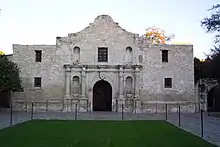

 USS Lexington floating museum in Corpus Christi
USS Lexington floating museum in Corpus Christi San Agustin Cathedral in Laredo's San Agustin de Laredo Historic District
San Agustin Cathedral in Laredo's San Agustin de Laredo Historic District Republic of the Rio Grande Capitol building is located in Laredo
Republic of the Rio Grande Capitol building is located in Laredo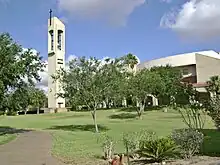 Basilica of San Juan del Valle in San Juan
Basilica of San Juan del Valle in San Juan
Education
Colleges
- Alamo Community College District
- Coastal Bend College
- Del Mar College
- Laredo Community College
- South Texas College
- Main Campus, McAllen
- Tech Campus, McAllen
- Nursing and Allied Health Campus, McAllen
- Mid-Valley Campus, Weslaco
- Starr County Campus, Rio Grande City
- Texas State Technical College
- Texas Southmost College
Public universities
- Texas A&M International University (Laredo)
- Texas A&M University–Corpus Christi
- Texas A&M University–Kingsville (Texas A&I)
- Texas A&M University–San Antonio
- University of Houston–Victoria
- University of Texas Health Science Center at San Antonio
- University of Texas at San Antonio
- University of Texas Rio Grande Valley (2015)
Private universities
Sports
The only major professional sports team in South Texas is the San Antonio Spurs in the NBA.
Area codes
- 210 - San Antonio, Bexar County
- 361 - Corpus Christi, Alice, Victoria, Kingsville, Rockport, Falfurrias
- 726 - San Antonio metropolitan area
- 830 - Eagle Pass, Floresville
- 956 - Laredo, Brownsville, McAllen, Mission, Edinburg
- 979 - only the southern half of this area is in South Texas
See also
References
- ↑ Mean monthly maxima and minima (i.e., the highest and lowest temperature readings during an entire month or year) calculated based on data at said location from 1991 to 2020.
- ↑ Official records for San Antonio were kept at downtown from March 1885 to December 1940, at Stinson Municipal Airport from January 1941 to June 1942, and at San Antonio Int'l since July 1942. For more information, see Threadex
- ↑
- ↑ "south texas houston, tx - Google Maps". Google Maps. January 1, 1970. Retrieved October 30, 2012.
- ↑ "NowData − NOAA Online Weather Data". National Oceanic and Atmospheric Administration. Retrieved May 31, 2021.
- ↑ "Station Name: TX SAN ANTONIO INTL AP". U.S. Climate Normals 2020: U.S. Monthly Climate Normals (1991−2020). National Oceanic & Atmospheric Administration. Archived from the original on December 25, 2023. Retrieved May 31, 2021.
- ↑ "WMO Climate Normals for SAN ANTONIO/INTL, TX 1961–1990". National Oceanic and Atmospheric Administration. Archived from the original on December 25, 2023. Retrieved July 19, 2020.
- ↑ "Average Weather for Laredo, TX – Temperature and Precipitation". Weather.com. June 2011. Retrieved May 7, 2009.
- ↑ "National Weather Service Brownsville". Weather.gov. July 21, 2006. Retrieved October 30, 2012.
- ↑ "Climatological Information for Brownsville, United States". Hong Kong Observatory. Archived from the original on October 23, 2019. Retrieved January 22, 2011.
- ↑ "National Weather Service Corpus Christi". Archived from the original on January 2, 2008. Retrieved June 29, 2008.
- ↑ "Pigfish (Orthopristis chrysoptera)". Tpwd.state.tx.us. Retrieved October 30, 2012.
- ↑ Texas Population 2017 World Population Review
- ↑ "How the Eastside Became Home to San Antonio's Black Community". San Antonio Report. January 15, 2018. Retrieved December 14, 2020.
- ↑ Henry C. Dethloff, "RICE CULTURE," Handbook of Texas Online, accessed March 20, 2012. Published by the Texas State Historical Association.
- ↑ Aransas County Airport Website Aransas Co Airport Call Sign: RKP(U.S), KRKP(International)